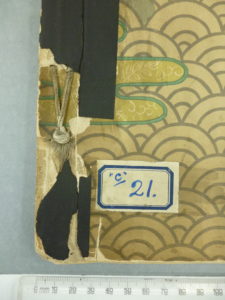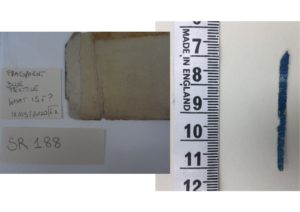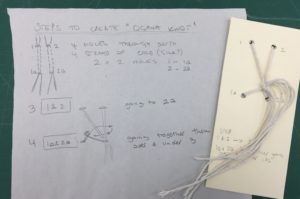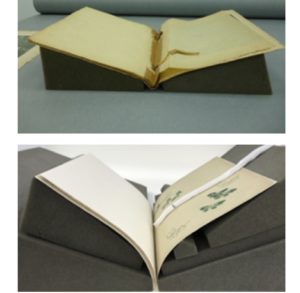Conservation: rebinding Ogawa
The process of conservation revealed unexpected and fascinating details about the construction of these Ogawa albums of collotypes, which helps shed light on their history as part of a dialogue between Japan and the West.
Recent conservation work on Lilies of Japan and Chrysanthemums of Japan involved taking both albums apart for cleaning and repair. Our conservator Lara Speroni made some interesting discoveries.
Dis-binding a volume can reveal hidden features and bring up questions and associations that are often fascinating. These volumes were made for export to a Western market during the Meiji period, when Japan had opened up to trade in goods and ideas with Europe and America. Our conservator, Lara Speroni, found interesting evidence of a hybridization of traditional Japanese binding methods and western production techniques as she carefully dismantled the volumes.
The Ogawa albums are not complex in structure. They comprise a functional and effective way to assemble numbers of collotype plates together for transport and sale to a European market hungry for Japanese art, tradition and culture. The albums consist of black and white (and some colour) collotypes printed on a heavy paper support, with a much lighter protection sheet adhered along the left edge of each image page.
A cover made out of two decorated thick cards protects the prints. All these elements are kept together via a simple stab-sewing structure of silk cords passing through the depth of the album and knotted at the front, head and tail, in a cross pattern. Or that’s what we thought…
hidden secrets of Japanese binding revealed

stab sewing of album spine seen from above
Pulling apart Lilies of Japan revealed that under the cover and in between the main sewing stations (two holes each, overall 4 holes) there were staples holding the leaves together during the sewing process. The staples had the potential to keep the pages together even if the outer sewing failed. This so-called ‘inner binding’ (or Koyori in Japanese), would have traditionally comprised Japanese paper strips twisted, then knotted, once inserted through the book’s depth. The introduction of metal staples made the process quicker and perhaps more in keeping with those western production methods which Japan was keen to absorb. Interestingly the Koyori technique was not adopted in Chrysanthemums of Japan.
Taking the albums apart also revealed narrow strips of bright blue textile sitting just under the cover by the spine edge of the first/and last print. The remaining cloth was few millimetres wide, and covered the length from the stab sewing to the head/tail edge.
These are remnants of ‘corner pieces’ named Kadogire which were traditionally adhered across the top and bottom portions of the spine, to keep the plates together. Usually, these would be missing as the material is thin and it easily wears off and breaks.

Detail of textile fragment discovered between cover boards and textblock
a final discovery
Lara made one last discovery in Chrysanthemums of Japan, which would have gone unnoticed unless she had taken the album apart. This was the presence of three strips of paper sewn between the last plate and the cover. These strips remain a bit of a puzzle. She initially thought that they were remnants of missing plates but when comparing them with Ogawa albums in other collections viewable online, this appeared not to be the case.
A second option was that the album’s colophon had been torn off and subsequently lost. However we later learned that colophons in other copies of Ogawa’s albums were smaller in size than the rest of the prints. Unfortunately the fragments make it difficult to tell the exact dimension of the missing leaves.
re-binding

diagram of knots used for rebinding Ogawa albums
Lara selected an unbleached cotton cord to replace the silk cord when replicating the original stab sewing technique.
Lara need to create a more flexible binding structure so that viewing the prints would not put strain on the first few prints when opening the album. To do this she used twisted and knotted paper ‘staples’ in place of the metal ones. This created a sort of hybrid version of the western staple and the Japanese koyori!
She also added four blank leaves of medium weight Japanese paper at the front and back of the volumes. These end-leaves take the strain of opening and closing the volume for consultation much better and limit the risk of tearing and page fracture which had occurred in the first and last pages historically.

Ogawa album before and after conservation re-binding
The photograph shows the album re-bound with additional end-leaves.
The process of conservation revealed unexpected and fascinating details about the construction of these Ogawa albums of collotypes, which helps shed light on their history as part of a dialogue between Japan and the West.